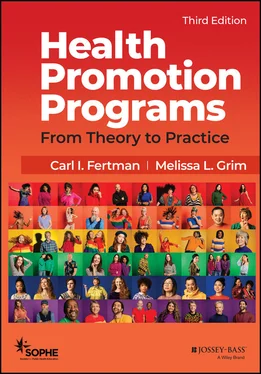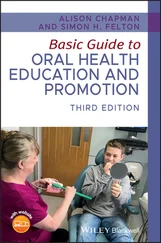(SOPHE) Society for Public Health Education - Health Promotion Programs
Здесь есть возможность читать онлайн «(SOPHE) Society for Public Health Education - Health Promotion Programs» — ознакомительный отрывок электронной книги совершенно бесплатно, а после прочтения отрывка купить полную версию. В некоторых случаях можно слушать аудио, скачать через торрент в формате fb2 и присутствует краткое содержание. Жанр: unrecognised, на английском языке. Описание произведения, (предисловие) а так же отзывы посетителей доступны на портале библиотеки ЛибКат.
- Название:Health Promotion Programs
- Автор:
- Жанр:
- Год:неизвестен
- ISBN:нет данных
- Рейтинг книги:5 / 5. Голосов: 1
-
Избранное:Добавить в избранное
- Отзывы:
-
Ваша оценка:
- 100
- 1
- 2
- 3
- 4
- 5
Health Promotion Programs: краткое содержание, описание и аннотация
Предлагаем к чтению аннотацию, описание, краткое содержание или предисловие (зависит от того, что написал сам автор книги «Health Promotion Programs»). Если вы не нашли необходимую информацию о книге — напишите в комментариях, мы постараемся отыскать её.
Health Promotion Programs: From Theory to Practice
Health Promotion Programs: From Theory to Practice
Health Promotion Programs — читать онлайн ознакомительный отрывок
Ниже представлен текст книги, разбитый по страницам. Система сохранения места последней прочитанной страницы, позволяет с удобством читать онлайн бесплатно книгу «Health Promotion Programs», без необходимости каждый раз заново искать на чём Вы остановились. Поставьте закладку, и сможете в любой момент перейти на страницу, на которой закончили чтение.
Интервал:
Закладка:
Source : Use Healthy People 2030 in Your Work, U.S. Department of Health and Human Services, 2020.
Health Education and Health Promotion
Health promotion has its roots in America in health education(Chen,2001). In the United States, health education has been in existence for more than a century. The first academic programs trained health educators to work in schools, but the role of health educators working within communities did not become popular until the 1940s and 1950s.
Health education promotes a variety of learning experiences to facilitate voluntary actions conducive to health (Green et al., 1980). These educational experiences facilitate gaining new knowledge, adjusting attitudes, and acquiring and practicing new skills and behaviors that could alter individual (one-to-one) or group instruction through personal online or group communication. Mass communication strategies can stimulate behavior change through public service announcements, webinars, social marketing techniques, and other evolving communications vehicles such as text messaging to blogging.
Health promotion has been defined as the combination of two levels of action: (1) health education and (2) environmental actions to support the conditions for healthy living (Green & Kreuter, 1999). Environmental actions prioritize populations in organizations and the community. Such environmental strategies and interventions include political, economic, social, organizational, regulatory, and legislative changes that can improve the health groups of individuals ( Table 1.2).
Table 1.2 Components of Health Promotion Programs
| Health Education to Improve Individual Health | Environmental Actions to Promote Health |
|---|---|
| Health knowledge Health attitudes Health skills Social support Health behaviors Health indicators Health status | Advocacy Environmental change related to variables influencing health outcomes (e.g., education, transportation, housing, criminal justice reform) Legislation Policy mandates, regulations Financial investment in communities and other resource/community development Organizational development Criminal justice reforms |
The priorities for health promotion programs identified by the World Health Organization (1998) are advocacy for health to create the essential conditions for health, enabling all people to achieve their full health potential and mediating between the different interests in society in the pursuit of health.
Health promotion uses complementary strategies at both personal and population levels. In the past, health education was used as a term to encompass the wider range of environmental actions. These methods are now encompassed in the term health promotion , and a narrower definition of health education is used to emphasize the distinction.
Health education as a discipline has a distinct body of knowledge, a code of ethics, a skill-based set of competencies that is scientifically updated every five years, a rigorous system of quality assurance, and a system for credentialing health education professionals (Knowlden et al., 2020). With the latest credentialing study, there are now eight competencies (areas of responsibilities for health education specialists) as the centerpiece of credentialing as well as the foundation for preparation programs ( Table 1.3). Approximately 250 professional preparation programs offer degrees in health education at the baccalaureate, master’s, or doctoral levels (Alber et al., 2020).
Table 1.3 Eight Competencies: Areas of Responsibilities for Health Education Specialists (HESPA II 2020)
| AREA I | Assessment of Needs and Capacity |
| AREA II | Planning |
| AREA III | Implementation |
| AREA IV | Evaluation and Research |
| AREA V | Advocacy |
| AREA VI | Communication |
| AREA VII | Leadership and Management |
| AREA VIII | Ethics and Professionalism |
| Source : HESPA II 2020, Responsibilities and Competencies for Health Education Specialists, NCHEC. © 2020, National Commission for Health Education Credentialing, Inc. |
The distinct occupation of health educator is recognized and tracked by the U.S. Department of Labor, which estimated that there were 123,800 health educators in the workforce in 2018 (U.S. Department of Labor, Bureau of Labor Statistics, 2020a). According to the Bureau of Labor Statistics, the demand for health educators is expected to increase by more than 19 percent, almost twice as fast as all other occupations of 11 percent growth (U.S. Department of Labor, Bureau of Labor Statistics, 2020b). The growth is driven by efforts to improve health outcomes and to reduce healthcare costs by teaching people about healthy habits and behaviors and utilization of available healthcare services.
Settings for Health Promotion Programs
Earlier in this chapter, we discussed the impact of the Jakarta Declaration in giving prominence to the concept of the health setting as the place or social context in which people engage in daily activities and in which environmental, organizational, and personal factors interact to affect health and well-being. Health is promoted through interactions with people who work in various settings, through people’s use of settings to gain access to health services, and through the interaction of different settings.
Schools
Schools are pivotal to the growth and development of healthy children and adolescents. School settings include childcare; preschool; kindergarten; elementary, middle, and high schools; and vocational-technical programs. The model for promoting and protecting the health of children and adolescents in schools is to place students in the center of the entire school community to promote their cognitive, physical, social, and emotional development with coordinated health policies, processes, and practices that promote learning and health. In schools, health promotion happens in ten areas: (1) Health Education, (2) Physical Education and Physical Activity, (3) Nutrition Environment and Services, (4) Health Services, (5) Counseling, Psychological, and Social Services, (6) Social and Emotional Climate, (7) Physical Environment, (8) Employee Wellness, (9) Family Engagement, and (10) Community Involvement (ASCD®, 2021). Health promotion in schools is done in the context of the community. Recognizing that schools are part of and an extension of the larger community within which it operates and serves its students (ASCD®, 2021).
Colleges and Universities
Colleges and universities—including 2-year college (community college), certificate programs, advanced vocational training, 4-year college (bachelor programs), graduate programs, and professional programs—place a prominent role in promoting the health of young adults as well as non-traditional students (for example, adults seeking a career change or retired individuals seeking enrichment). Boosting educational attainment beyond high school has been more prominent in recent years. Given the future of work and the increasing role of technology, education beyond high school becomes even more relevant for workers to compete in the labor market. These sites have extensive programming and structures to provide healthcare and promote healthy lifestyles. Initiatives such as Healthy Campus 2020 (American College Health Association, 2020) empower schools to improve health and well-being by creating a culture where social and physical environments promote health. Health promotion initiatives at colleges and universities need to be part of how the sites assertively address persistent racial/ethnic gaps in educational attainment. Even as we see higher rates of attainment among the younger working-age population, gaps among particular components of that group are also larger in spite of so many efforts to close them (Prescott, 2019).
Читать дальшеИнтервал:
Закладка:
Похожие книги на «Health Promotion Programs»
Представляем Вашему вниманию похожие книги на «Health Promotion Programs» списком для выбора. Мы отобрали схожую по названию и смыслу литературу в надежде предоставить читателям больше вариантов отыскать новые, интересные, ещё непрочитанные произведения.
Обсуждение, отзывы о книге «Health Promotion Programs» и просто собственные мнения читателей. Оставьте ваши комментарии, напишите, что Вы думаете о произведении, его смысле или главных героях. Укажите что конкретно понравилось, а что нет, и почему Вы так считаете.












